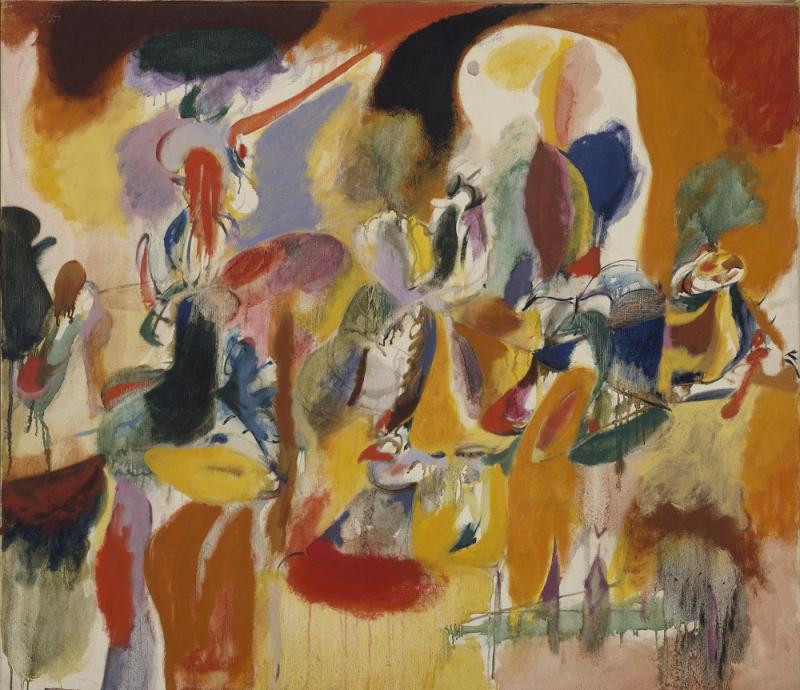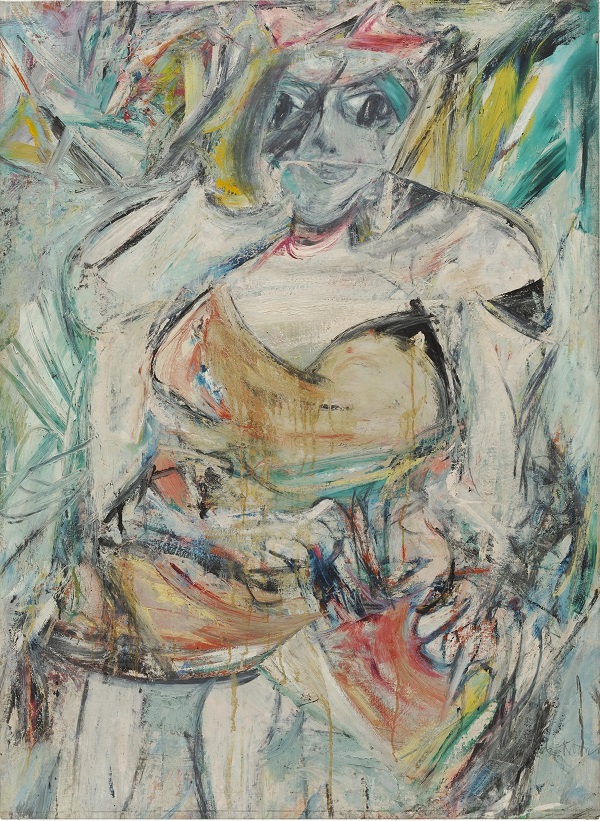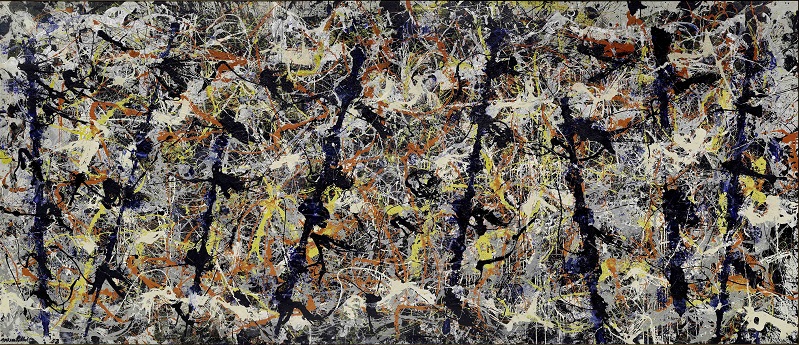Abstract Expressionism, Royal Academy | reviews, news & interviews
Abstract Expressionism, Royal Academy
Abstract Expressionism, Royal Academy
Energy, alcohol and bucketloads of paint: a triumphant reunion for New York's most exciting artists

Gorgeous, sumptuous, thrilling: here comes Abstract Expressionism riding into town, the first major overview in London since its own contemporary heyday in the 1950s. A clunky, unappealing label for such fabulously appealing stuff, it's best just to relax and enjoy this total immersion, for colour and gesture can never have been combined to such memorable effect.
The diversity of its very loosely allied participants means that the labelling is just a convenient handle: here are midwesterners, westerners, city boys, immigrants, working class to upper class connected by friendship, casual acquaintance, alcohol and rivalry. Willem de Kooning was Dutch, Mark Rothko born in Russia, Barnett Newman a secular Jewish New Yorker, Jackson Pollock was born in Wyoming and got to New York via California (and a Jungian analysis). Arshile Gorky was an Armenian immigrant, while Robert Motherwell, the son of a banker, was the most politically engaged member of the New York School. All were young – in their late twenties and thirties – when they embarked on these visual revolutions (main picture: Arshile Gorky, Water of the Flowery Mill, 1944).
 This magnificent and beautiful exhibition is a triumph for the Royal Academy, its marvellous sequence of galleries on the piano nobile as suited to the grandeurs of large-scale modern American art as to Old Masters. Abstract Expressionism is a term that has been around a long time, used to describe the startling visions of one of the great innovators of abstraction, Kandinsky, and by the 1940s appearing in The New Yorker, applied to the young emerging artists themselves. The country’s leading intellectual magazine specifically attached the phrase to this restless, energetic, volatile and at times tragic group of painters, with here, according to the RA’s choice, one leading sculptor, David Smith, who, gifted welder as he was, worked on an industrial scale, drawing in space. His dazzling and playful work, hovering between representation, abstraction and three-dimensional doodling, processes through the centre of most galleries, and a mighty handful showing the great range of his various idioms inhabits the Royal Academy courtyard.
This magnificent and beautiful exhibition is a triumph for the Royal Academy, its marvellous sequence of galleries on the piano nobile as suited to the grandeurs of large-scale modern American art as to Old Masters. Abstract Expressionism is a term that has been around a long time, used to describe the startling visions of one of the great innovators of abstraction, Kandinsky, and by the 1940s appearing in The New Yorker, applied to the young emerging artists themselves. The country’s leading intellectual magazine specifically attached the phrase to this restless, energetic, volatile and at times tragic group of painters, with here, according to the RA’s choice, one leading sculptor, David Smith, who, gifted welder as he was, worked on an industrial scale, drawing in space. His dazzling and playful work, hovering between representation, abstraction and three-dimensional doodling, processes through the centre of most galleries, and a mighty handful showing the great range of his various idioms inhabits the Royal Academy courtyard.
Elaine de Kooning, wife to Willem, the depicter of huge, rollicking frolicking women, liked to talk about "Abstract Impressionism", a phrase that does fit the wonderfully luminous Rothkos, which enlighten the central rotunda of the galleries (pictured above right: Willem de Kooning, Woman II, 1952). Joni Mitchell observed that Abstract Expressionism was invented by New York drunks, but leaving alcohol aside (difficult to do, as drinking killed Jackson Pollock in a car crash), these artists were visionaries, bearing out the critical observation that in many respects it was a religious movement. The huge paintings of Barnett Newman make for walls of resplendent, resonant colour, punctuated by great vertical stripes: declared agnostic/atheist as he was, they are irresistibly, overwhelmingly spiritual in effect.
'Mural' is as airy as 'Blue Poles' is dense, but both exploit the athletic choreography of their making The introductory gallery is helpful, introducing the visitor to the artists with tentative, searching and curiously intent self-portraits, with excursions into small exercises in semi-abstract paintings. Early careers were initiated during the Depression of the 1930s, with help coming from the government’s New Deal programmes, which involved the commissioning of artists for public work. Insecurity was rife and the war exacerbated anxiety; Robert Motherwell remarked in the 1970s that the expressionist part of this very confusing label had to do with “a certain anxiety and a certain violence” endemic to the American scene. This was an American art “filled with anger as well as beauty”. What is undeniable are the hints at representation, from horizons and skies to organic tangles that permeate much of the work, and a very high quotient of communicable emotion.
And so perhaps to the star of this compelling show, Jackson Pollock, nicknamed Jack the Dripper. There are two terrific scoops here in the main gallery. Blue Poles (No.11), 1952 (pictured below), which brought down the Australian government when the country spent $1.3 million on its acquisition, is a star of the Australian National Gallery in Canberra, and in retrospect a symbol of the country’s cultural coming of age. Newly cleaned, its overall vitality, as skeins of glistening colour process across its surface, remains, more than 60 years after its creation, as compellingly audacious as ever. The Royal Academy's coup de théâtre is to have Blue Poles hanging opposite the biggest painting Pollock ever made, the mural commissioned by the collector, gallerist and Pollock’s patron, Peggy Guggenheim, for the narrow front hall of her New York apartment. Mural is as airy as Blue Poles is dense, but both exploit the athletic choreography of their making as Pollock cast out lures in enamel paint over vast floor-covering canvases. Mural is said to have been painted on New Year’s Day 1944, with Pollock having a stampede of every herd animal in the West in mind – it is nine by nearly 20 feet in dimension and his largest painting.
 Ambitious, gallant, powerful, it really set the scene for the originality and genuine excitement that was unleashed by these artists. The sheer energy and optimism, which transcended personal tragedy, made this new art, nevertheless informed by a profound interest in past art, enormously appealing to postwar Europe, particularly Germany as its economy recovered. It was a movement too that was covertly supported as part of soft diplomacy by American agencies operating internationally.
Ambitious, gallant, powerful, it really set the scene for the originality and genuine excitement that was unleashed by these artists. The sheer energy and optimism, which transcended personal tragedy, made this new art, nevertheless informed by a profound interest in past art, enormously appealing to postwar Europe, particularly Germany as its economy recovered. It was a movement too that was covertly supported as part of soft diplomacy by American agencies operating internationally.
There are some caveats: the attempts to cover smaller works on paper and allied photography are too bitty, the rather arbitrary mixed selection of later works in the last gallery confusing, although even here there is a bonus in a four-panel burst of dappled blues and yellows by the underrated Joan Mitchell.
The exhibition is unmissable for anyone interested in post-war art, let alone cultural history. As well as the generally accepted international stars, there are some less familiar artists here too, from Lee Krasner, Pollock’s wife, with a huge swirling abstract, to the exquisite, minutely rendered, tangled, painted embroideries of Mark Tobey. No single museum collection can match the compilation at the RA, which has come from collections worldwide, including public and private collections in two dozen American states, not to mention Germany, Denmark, Sweden, France, Italy, Portugal and Israel. This anthology is a rare opportunity which will not come our way again.
rating
Share this article
The future of Arts Journalism
You can stop theartsdesk.com closing!
We urgently need financing to survive. Our fundraising drive has thus far raised £49,000 but we need to reach £100,000 or we will be forced to close. Please contribute here: https://gofund.me/c3f6033d
And if you can forward this information to anyone who might assist, we’d be grateful.

Subscribe to theartsdesk.com
Thank you for continuing to read our work on theartsdesk.com. For unlimited access to every article in its entirety, including our archive of more than 15,000 pieces, we're asking for £5 per month or £40 per year. We feel it's a very good deal, and hope you do too.
To take a subscription now simply click here.
And if you're looking for that extra gift for a friend or family member, why not treat them to a theartsdesk.com gift subscription?
more Visual arts
 'We are bowled over!' Thank you for your messages of love and support
Much-appreciated words of commendation from readers and the cultural community
'We are bowled over!' Thank you for your messages of love and support
Much-appreciated words of commendation from readers and the cultural community
 Lee Miller, Tate Britain review - an extraordinary career that remains an enigma
Fashion photographer, artist or war reporter; will the real Lee Miller please step forward?
Lee Miller, Tate Britain review - an extraordinary career that remains an enigma
Fashion photographer, artist or war reporter; will the real Lee Miller please step forward?
 Kerry James Marshall: The Histories, Royal Academy review - a triumphant celebration of blackness
Room after room of glorious paintings
Kerry James Marshall: The Histories, Royal Academy review - a triumphant celebration of blackness
Room after room of glorious paintings
 Folkestone Triennial 2025 - landscape, seascape, art lovers' escape
Locally rooted festival brings home many but not all global concerns
Folkestone Triennial 2025 - landscape, seascape, art lovers' escape
Locally rooted festival brings home many but not all global concerns
 Sir Brian Clarke (1953-2025) - a personal tribute
Remembering an artist with a gift for the transcendent
Sir Brian Clarke (1953-2025) - a personal tribute
Remembering an artist with a gift for the transcendent
 Emily Kam Kngwarray, Tate Modern review - glimpses of another world
Pictures that are an affirmation of belonging
Emily Kam Kngwarray, Tate Modern review - glimpses of another world
Pictures that are an affirmation of belonging
 Kiefer / Van Gogh, Royal Academy review - a pairing of opposites
Small scale intensity meets large scale melodrama
Kiefer / Van Gogh, Royal Academy review - a pairing of opposites
Small scale intensity meets large scale melodrama
 Jenny Saville: The Anatomy of Painting, National Portrait Gallery review - a protégé losing her way
A brilliant painter in search of a worthwhile subject
Jenny Saville: The Anatomy of Painting, National Portrait Gallery review - a protégé losing her way
A brilliant painter in search of a worthwhile subject
 Abstract Erotic, Courtauld Gallery review - sculpture that is sensuous, funny and subversive
Testing the boundaries of good taste, and winning
Abstract Erotic, Courtauld Gallery review - sculpture that is sensuous, funny and subversive
Testing the boundaries of good taste, and winning
 Edward Burra, Tate Britain review - watercolour made mainstream
Social satire with a nasty bite
Edward Burra, Tate Britain review - watercolour made mainstream
Social satire with a nasty bite
 Ithell Colquhoun, Tate Britain review - revelations of a weird and wonderful world
Emanations from the unconscious
Ithell Colquhoun, Tate Britain review - revelations of a weird and wonderful world
Emanations from the unconscious
 Rachel Jones: Gated Canyons, Dulwich Picture Gallery review - teeth with a real bite
Mouths have never looked so good
Rachel Jones: Gated Canyons, Dulwich Picture Gallery review - teeth with a real bite
Mouths have never looked so good

Add comment